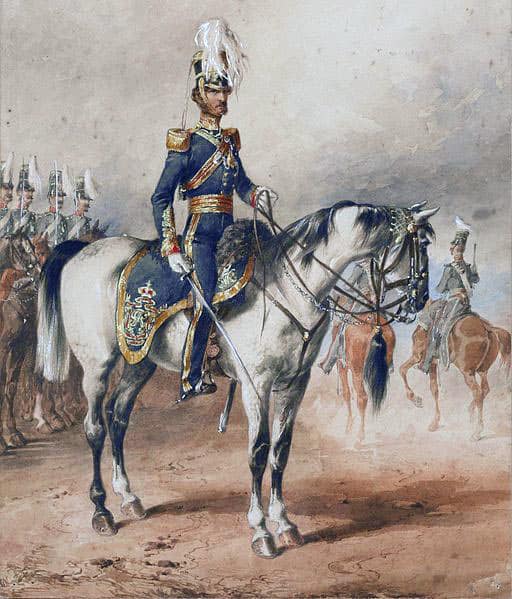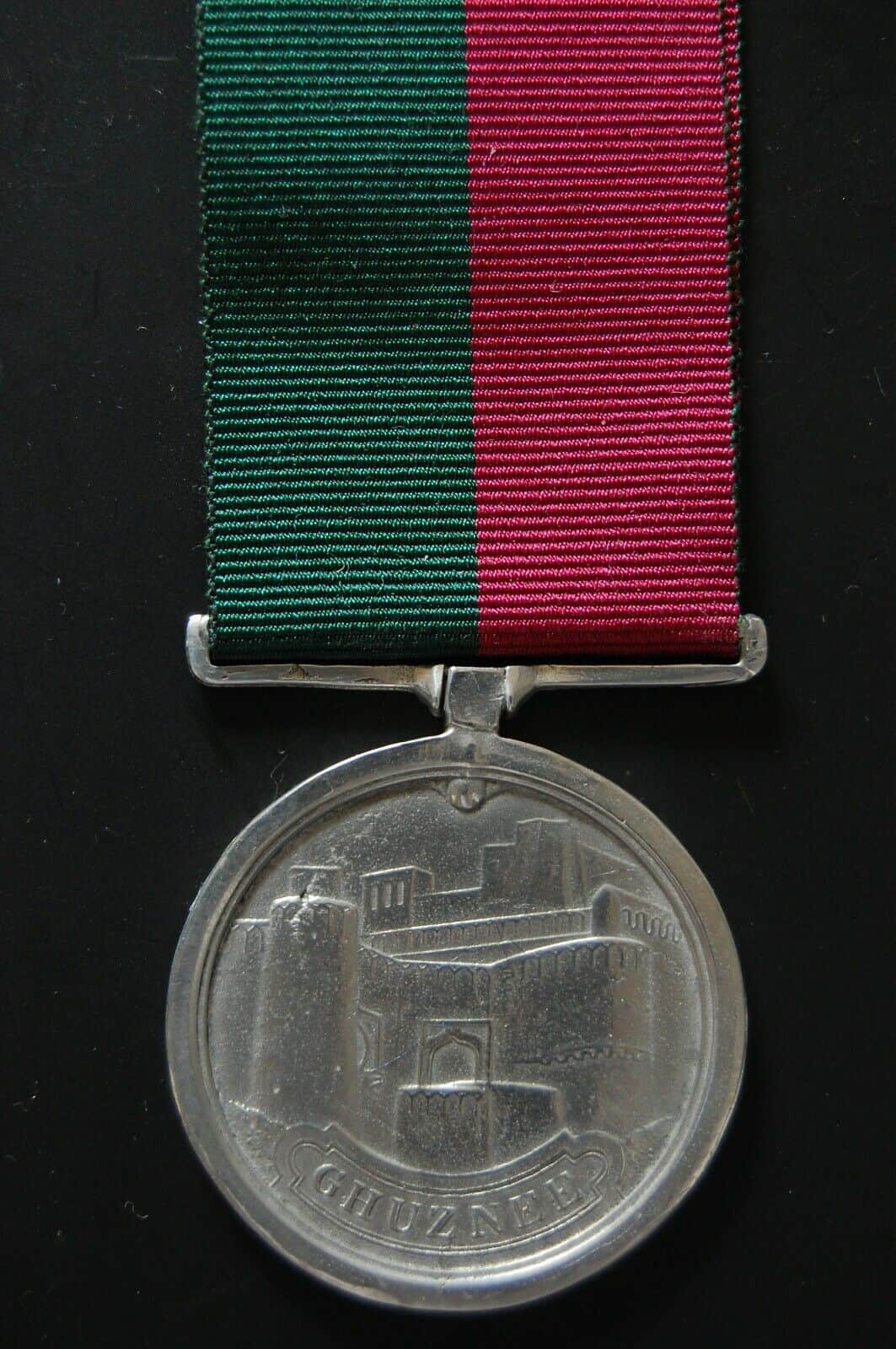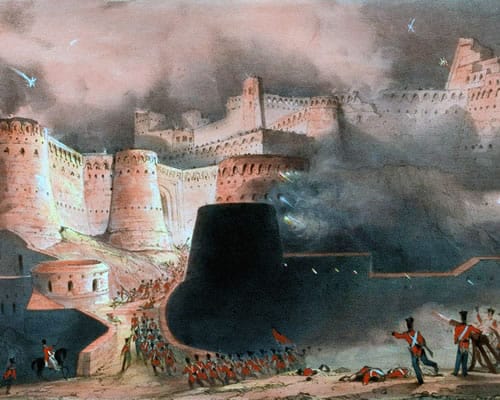I became interested in the First Afghan Campaign several years ago when I purchased a Ghuznee Medal awarded to Private Joseph Wilson, 4th (Queen’s Own) Light Dragoons, and later another to a Private Joseph Selby. What made Wilson’s medal of particular interest were the copies of his attestation documents and record of service that came with it. They brought to life an otherwise rather dull, old piece of metal with the image of some distant fort on its obverse and the man to whom it had been presented.
Whilst I had no real idea where Ghuznee was, or for what reason a medal had been struck to commemorate the place, a distant memory stirred from David Scott Daniel’s History of the 4th Hussars of a short but grim campaign in the summer of 1839.
It is not the purpose of this article to recount the history of the campaign, but the scene needs to be set. It is simplest to trace the roots of this First Afghan War to the overthrow of Amir Shah Shujah in 1809 which resulted in his kingdom (loosely the region we would term Afghanistan, but extending east into the Punjab) being split in two.; Amir Dost Mohammed controlled the western portion, centred on Kabul, and Ranjit Singh the eastern portion.

Britain stood back from any involvement in the dispute until Shujah made an alliance with Ranjit Singh to overthrow Dost Mohammed; she saw advantage in having a compliant ruler in control and eventually proposed an ‘Army of the Indus’ to bolster Shujah’s chances.
The 4th Light Dragoons provided a detachment of 16 officers and 300 men (effectively two squadrons) to the Bombay division that was to meet with a similar force from the Bengal Presidency, both forming the Army of the Indus.
The 4th Light Dragoons’ detachment left its barracks at Kirkee in November 1838 marched to Bombay and then travelled by ship to just short of Karachi. From there they marched well over 1000 miles before reaching Kabul in August the following year.
The route was long, arduous and through largely hostile territory; the journey from Kalat through the Bolan pass to Quetta being the lowest point.
The British marched north from Quetta on 7 April 1839 and under their protection, Shah Shujah entered Kandahar on 25 April. It was here that the two parts of the Army of the Indus met and then paused for two months to recuperate.
The army left Kandahar on 27 June for Kabul knowing that Ghuznee with its fortress lay before them. The Army approached Ghuznee on 20 July and the Commander-in-Chief, Sir John Keane, soon decided after some minor skirmishes with the defenders and a sound reconnaissance, to stun the fortress quickly rather than lay siege to it. Under the cover of darkness, a party of sappers planted 300 lbs. of gunpowder outside the weakest gate of the fortress and successfully blew the gate. The infantry then stormed through and into the fortress city; it was a hard fight, but the British flag flew from the battlements by first light.
The loss of Ghuznee ended Dost Mohammed’s chances of retaining power and on 2 August he fled north from Kabul towards the Hindu Kush and Shah Shujab formally entered Kabul five days later. Having re-established Sbujah on his throne the British were keen to return their troops to India, although it soon became evident that Shujah’s position was far from stable and some troops would have to remain. However, the Bombay division left Kabul on 18 September and the 4th Light Dragoons’ detachment eventually returned to Kirkee on 30 March 1840.
After the capture of the Ghuznee, Shah Sbujah announced his intention to confer a medal upon the troops who took part in the action, as a mark of the high esteem in which he held their gallantry.

The medal was manufactured at the Government of India Mint in Calcutta, the die being made by a local firm, Messrs Pittar & Co. The obverse of the medal shows the fortress of Ghuznee, with the name below it. The reverse shows a mural crown within two laurel branches, with above ’23rd July’ and below ‘1839’; there is also a space for the recipient’s name and regiment to be engraved. It hangs from a ribbon half crimson and half green.
Unfortunately but perhaps unsurprisingly, Shah Shujah was assassinated in Kabul before it could be issued. However, the medal was finally issued, unnamed, by the Government of India in 1842. The recipient’s details were subsequently engraved in flowing script or neat capitals. There is a short exchange of letters from 1844 between the War Office and the Royal Mint concerning the engraving of the medals; the former wanting them impressed around the rim, as had been the case for the Waterloo Medal, to prevent ‘medals being fraudulently applied’.
The chief engraver at the Mint eventually persuaded the War Office otherwise primarily on grounds of expense. It might at first seem rather surprising that this method of naming the medals should have been expensive, especially as it subsequently became standard practice for British campaign medals. It was because the Ghuznee medal was the first to be issued with a suspender as an integral part of the medal, previously medals were struck like coins and the ribbon suspender grasped hold of the edge of the medal with a decorative ‘claw’.
To this point, little has been said about a ‘soldier’s lot’ in 1839, so let me put that to rights.
Accounts of the campaign make it apparent that life on operations was arduous and challenging enough without an enemy complicating matters. The provision of rations and water, and fodder for the animals, was no easy or guaranteed business and almost the entire route of the Bombay division lay across arid plains with little grazing. Roads did not exist in the region capable of taking wheeled transport, so pack animals had to be used.
The grand total of camels used by the Army of the Indus was in excess of 30,000, each beast occupying 15 ft of road, travelling at approximately two mph, with 10 beasts a minute, if in single file, passing any given point. The passage through the Bolan Pass was particularly grim as already mentioned: ‘the route was along slippery stony tracks through wild mountains. Water and air were poisoned by the thousands of rotting carcasses of camp followers and animals of the Bengal division that had passed through three weeks before … there were constant struggles … over difficult places, and always the Baluchis were waiting to raid the column and murder stragglers’. Once in Afghanistan proper, the temperatures soared during the daytime and with a shade temperature of 125 degrees, the troops marched at night.
Life ‘in barracks’ was not correspondingly sweet. The rank and file of the 1830s were hardly the most willing or professional of soldiers, many being forced into service through poverty, domestic crisis, or a desire to escape justice. Service in India was not highly regarded, being described as: ‘one undivided continuance of listless indolence and monotonous drill’.
Soldiers resentment at their lot was often expressed in criminal acts: ‘they slip out of barracks after roll call, steal into the regimental or cantonment bazaar, pawn their accoutrements get drunk, quarrel with native shopkeepers, are found absent when their names are called over, and then, of course, are put under arrest’. Furthermore, this was the age of the lash which had come to prominence in the 1790s, as the Army’s most effective way (short of capital punishment) to maintain discipline. Wellington was a strong advocate and sentences in his day could run to 1000 lashes; his belief that ‘the real meaning of punishment, if it is to have any meaning, is an example’ inclined toward the harsher punishments.
However, by 1836 the number of lashes awarded was limited to 200 at General Courts-Martial, 150 at District and 100 at Regimental or Detachment. The Advocate General’s Department’s record of District Courts Martial shows not only the frequency of such events for the 4th Light Dragoons at Kirkee but also gives a flavour of the punishments awarded.
Private Morgan was found guilty of theft on 21 September 1840 and sentenced to 150 lashes; Private Brindley for his third offence of drunkenness in five months (two months of which were spent in solitary confinement) was sentenced to six months imprisonment on 9 October 1839, and one Private Hartford was sentenced to six months imprisonment for being ‘asleep on post’ on 12 August 1840. (Clearly, these punishments were to soldiers who remained behind at Kirkee once the detachment had left Afghanistan).
In drawing this article to a close, let us consider the lot of Privates Wilson and Selby whose Ghuznee Medals were its inspiration.
More is known about Wilson: he joined the Regiment on 4 July 1827, aged 19, having been a servant from the village of Polsted in Suffolk. He served with the 4th Light Dragoons until 9 November 1852 when he left to return to Suffolk still a Private. His service is recorded as follows: ‘of a good soldier although he was convicted by a Detachment Court Martial 18th June 1839 for inflicting a wound on Horses’ wither with his sword which caused its death; he is in possession of 3 Good Conduct Badges and of a Medal for the Storm & Capture of Ghuznee 1839.
As Wilson was sentenced to 100 lashes for causing the death of his horse, it is hard to conceive how he performed at Ghuznee a few weeks later! Also, even though it must be acknowledged that Ghuznee was an infantry action with the cavalry standing by, one wonders if the horse-less private was even present.
Finally, one can but wonder how successful he was in a second career, aged 44, in 1852 when the surgeon wrote: ‘Priv. Joseph Wilson 4th Lt Dragoons is graded unfit for further service in consequence of Chronic Rheumatism & being generally worn out. Has suffered also from Chronic Hepatitis which he contracted in the East lndies & for which he has frequently been under treatment at home: his complaints do not appear to have been the result of vice or intemperance, but are the result of long service in hot climates.
Private Selby on the other hand came from Lincolnshire and joined the regiment two years before Wilson, aged 18. His career is less well documented, but he spent 11 days in solitary confinement for an undisclosed offence in May 1838. Although his record of service does not say as much, one must assume he was witness to the capture of Ghuznee. Perhaps amazingly considering contemporary views of Service in India, Selby volunteered to transfer to the 14 Light Dragoons when they replaced the 4th at Kirkee in 1841. He was finally discharged in 1846.
In conclusion, taking the examples of Wilson and Selby, one must presume that (with apologies to Thomas Hobbs) a soldier’s lot was nasty, brutish but not necessarily short.
Lieutenant Colonel DJL Swann


